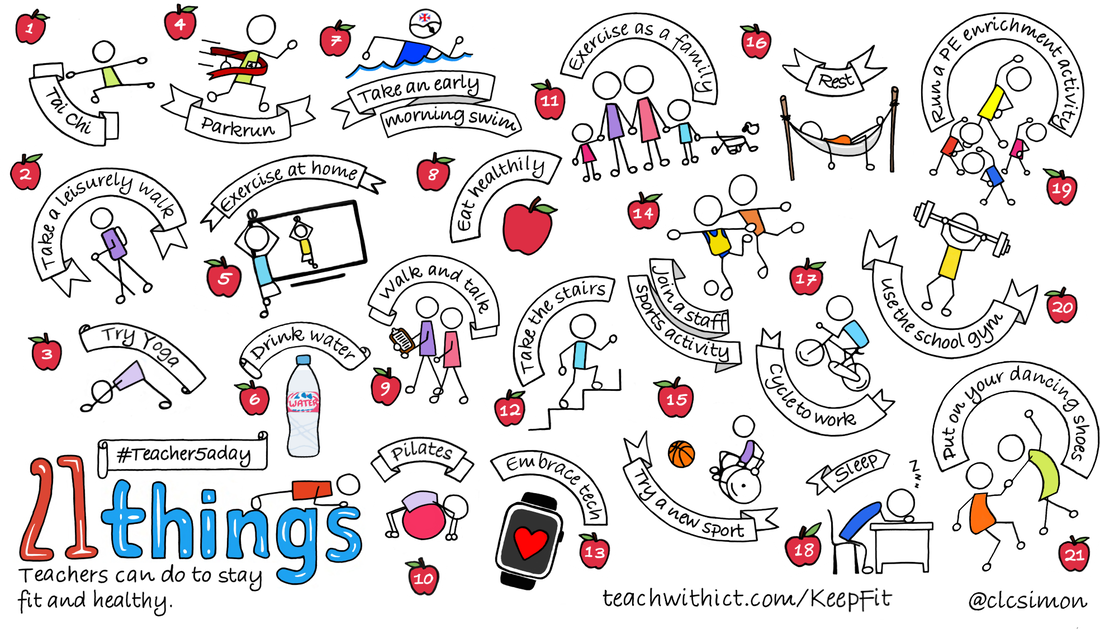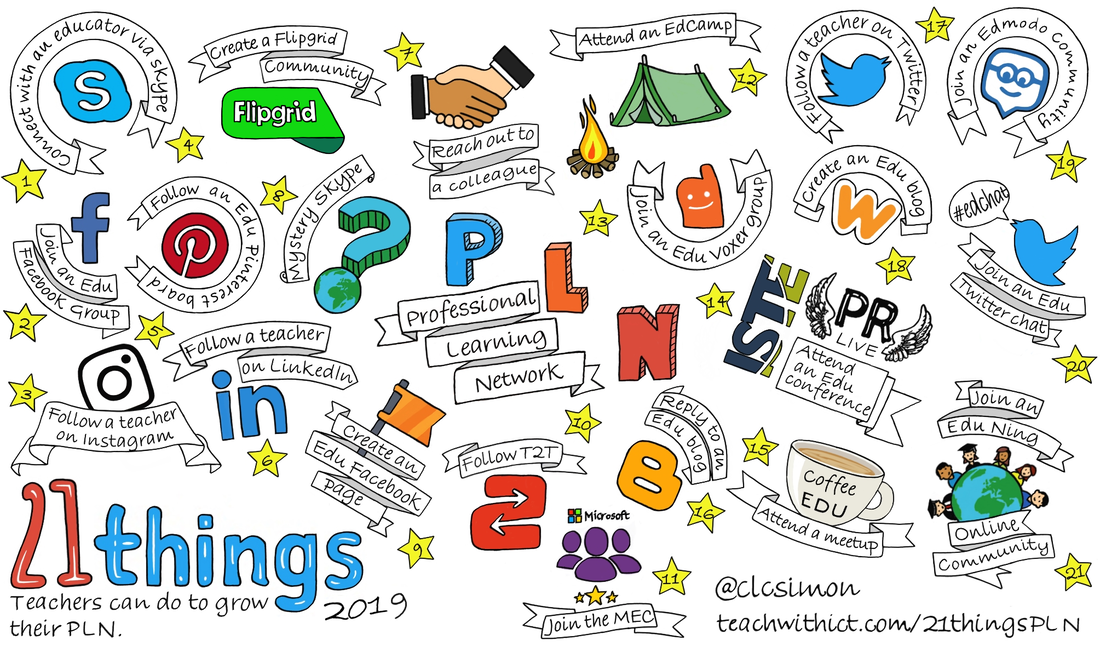21 things teachers can do to stay fit and healthy
Reading time: 8 mins
It is said that a healthy body equals a healthy mind but how is this achievable with the ever increasing demands of being a teacher? This is a question I asked the lovely people of Facebook & Twitter and this is what they suggested:
Introducing 21 things teachers can do to stay fit and healthy!
1. Tai Chi
Tai Chi is a low-impact form of exercise which combines deep breathing and meditation with gentle flowing movements. What’s great about Tai Chi is that anyone can participate, Tai Chi is accessible for all ages / abilities, and many of the moves are easily adaptable for those with disabilities. However, as with any new exercise regime, if you have any health concerns or an existing health condition, always seek guidance from your GP before taking up Tai Chi as you may need to take certain precautions, especially if you’re pregnant, have a hernia or back problems etc.
2. Take a leisurely walk
Just 10-15 minutes outside in the fresh air is all you need to re-compose your thoughts and reset yourself – even better if you combine this with a bit of exercise! Where possible, try to take time out in your busy schedule for a short leisurely walk. Whether it’s a quick trip to the shops or a leisurely walk with the dog, every step counts! Have a dog and fancy a slightly more strenuous workout? Try running with your dog instead of walking.
“Ran with the dogs rather than walk tonight and beat a personal not stopping at all 2.6miles!” - Laura Holdsworth @MrsHoldsworth
3. Try Yoga
Probably the most common misconception about yoga is that you must be super fit and able to perform ‘gravity-defying’ poses in order to take part. You will pleased to know that you don’t need to be a contortionist to enjoy the full benefits of yoga and just 5-10 minutes a day can lead to improved physical and mental well-being. Perhaps one of the most significant benefits of yoga, something particularly pertinent to teachers, is its ability to help manage stress. Research suggests that yoga can help reduce the levels of the stress hormone cortisol – a hormone also linked to depression.
“I get up at 5.30, short yoga warm-up, short treadmill run, short yoga stretch. Gets me psyched up for the day ahead, calmer and more positive mindset.” – @TheOther16Hours
Useful links:
- http://www.yoga4classrooms.com/benefits-of-yoga-in-schools
- 10 Easy Stress-Relief Yoga Poses to Prevent Teacher Burnout: https://education.cu-portland.edu/blog/lifestyle/calming-yoga-poses/
4. Park Run
“Try @parkrunUK – It’s free! 9am on a Saturday morning and a great start to the weekend!” – Victoria Danson @MrsDanno_PE
Don’t want to be tied down to a costly gym subscription but need motivation to keep fit? Why not try Parkrun!? Parkrun (parkrun.org.uk/) organise weekly, 5km timed runs all around the globe and, best of all, they’re free! These events take place in pleasant parkland surroundings, are open to everyone and easy to join!
If you’re interested in signing up to run at an existing parkrun event, or you fancy starting an event where you live, register your interest via: parkrun.org.uk/register
If you’re interested in signing up to run at an existing parkrun event, or you fancy starting an event where you live, register your interest via: parkrun.org.uk/register
“I run with a local running club on a Tuesday evening, try and get to parkrun at least every other weekend. I find the training a great way to put my thoughts in order and reset myself.” – @mrwareham_ihs
5. Exercise at home
After a long hard day at work, the prospect of going to the gym or out for a run may be the last thing on your mind! However, if a 5km run is not your cup of tea, there are still lots of simple alternatives – many of which can be done in the privacy and comfort of your own home! Whether it’s a few step-ups in front of the telly or 20 minutes on the Wii Fit, remember, every step counts! Top tip: I personally find that catching-up on missed TV such as an episode of Game of Thrones or NCIS, as opposed to listening to music, helps pass the time away when I’m on the the cross-trainer.
6. Drink water
If you consider that over 60% of your body is made of water, it should come as no surprise that staying well hydrated is an integral part of being fit and healthy. Unfortunately, despite this well-known fact, drinking enough fluids is something that is often easily overlooked. Research suggests that being dehydrated can affect your mood and mental wellbeing as well as potentially induce fatigue and headaches. There is much dispute over how much fluid you should drink with the general consensus recommending between 6 and 8 glasses a day. Water, low fat milk and sugar-free drinks, including tea and coffee, all count.
Top tips:
Top tips:
- Water is a cheap and healthy option however, if you don’t like the taste of plain water, try flavoured water or add a slice of lemon or lime.
- Make healthy drink choices! Try to avoid drinks that are high in sugar as these are often also high in calories – Plain tea, fruit teas and coffee (without added sugar) can be healthy alternatives.
- Drink with each meal and between each meal.
- Drink before, during and after exercise.
- Drink if you're feeling hungry (thirst can often be confused with hunger).
7. Go for an early morning swim
If you’re one of those early risers who likes to dive straight into work first thing, you may want to consider diving into a pool instead! Enjoying an early morning swim is a great way to give yourself a full body workout and burn off those un-necessary calories. Just 30 mins in the pool is all you need to reap the benefits and start your day feeling relaxed and energised!
“Been to the gym for a lovely long swim. It's only when I get back in it that I remember how much I adore water #relaxed” - Becky Wood @shadylady222
8. Eat healthily
You probably don’t need to be reminded that eating a healthy, balanced diet is an integral part of staying fit & healthy but, with the ever increasing demands of the job, sustaining a healthy / balanced diet can be a challenge even for the most conscientious of healthy eaters!
According to the Eatwell Guide (A free NHS guide to eating more healthily) eating a wide variety of foods in the right proportions, and consuming the right amount of food and drink all help to achieve and maintain a healthy body weight. According to the guide, people should try to:
For more advice on how to maintan a balanced / healthy diet, check out the NHS free 'Eat Well' guide: https://www.nhs.uk/live-well/eat-well/
According to the Eatwell Guide (A free NHS guide to eating more healthily) eating a wide variety of foods in the right proportions, and consuming the right amount of food and drink all help to achieve and maintain a healthy body weight. According to the guide, people should try to:
- eat at least 5 portions of a variety of fruit and vegetables a day
- base meals on starchy foods like potatoes, bread, rice or pasta
- have some dairy or dairy alternatives (such as soya drinks)
- eat some beans, pulses, fish, eggs, meat and other protein
- choose unsaturated oils and spreads, eaten in small amounts
- drink plenty of fluids
For more advice on how to maintan a balanced / healthy diet, check out the NHS free 'Eat Well' guide: https://www.nhs.uk/live-well/eat-well/
9. Walk and talk
Walking is a great form of exercise which has many benefits such as strengthening your heart and keeping your weight in check. So, instead of sending an email or sitting at your desk for a meeting. try walking and talking instead!
“I walk to see members of my team and others I need to speak to rather than send emails so I can check in with them too.” – Jessica Austin @artteachjess
10. Pilates
Similar to Yoga, Pilates concentrates on strengthening the body with a particular emphasis on posture, balance and flexibility. However, unlike Yoga, Pilates exercises are often performed using a combination of special apparatus and mats. As with Yoga, Pilates is suitable for all ages and abilities but, as with any new exercise regime, it’s always recommended that you seek advice from your GP or a health professional before trying something new, especially if you have pre-existing health issues or in any pain. To find out more, checkout the NHS guide to Pilates: https://www.nhs.uk/live-well/exercise/guide-to-pilates/
11. Exercise as a family
Exercise doesn’t have to be a solitary affair! Exercising as a family can have many benefits because not only can it support your physical and mental well-being but it can also strengthen family relationships and create lasting memories too. There are lots of ways to incorporate exercise into your daily life and best of all it doesn't have to involve going to the gym or spending lots of money. Family activities can include simple things such as kicking a ball, taking the dog for a walk, visiting your local park, or going for a family bike ride.
12. Take the stairs
You don’t have to hit the gym to get a good workout. Simple life choices like taking the stairs instead of using the lift can all make a huge difference.
13. Embrace technology
Fitness trackers, whilst not always 100% accurate, allow you to monitor your daily physical activity, count your calories, set targets/goals and much more. This can lead to improved overall health which, in-turn, can have a positive impact on your productivity and overall wellbeing! What I love about my fitness tracker is that, if I’ve managed to achieve 90% of my daily goals by the end of my working day, I will put in the little extra effort to meet my daily target!
#BOOM!
— Simon Johnson #Road2e2 (@clcsimon) March 28, 2019
Nothing beats an early evening walk to clear the mind and burn off a few calories along the way! □ pic.twitter.com/QfIrWEmznT
“My Apple Watch makes me think about my steps and helps me to make smart choices about my daily exercise routine” - @BradleyDardi
14. Join a staff sports activity
One thing I really miss is our staff 5-a-side football every Friday after-school. As well as improving my fitness, it was a great way to let my hair down and also hangout with members of staff from other departments who I would not normally see other than in staff meetings. It doesn’t even have to be 5-aside! I know many teachers who take part in a variety of after-school staff sporting activities including circuit training, net ball and even dodge-ball. Don’t know of any staff sporting opportunities happening at your school – why not ask around or even start your own after-school session!?
15. Try a new sport
Whether it's something you dreamed of doing as a child or something that has always took your fancy, it's never too late to try a new sport!
Set yourself the challenge of trying a new sport - not only will you improve your overall fitness, you may also learn new skills, meet new friends and even discover a new passion / hobby!
Set yourself the challenge of trying a new sport - not only will you improve your overall fitness, you may also learn new skills, meet new friends and even discover a new passion / hobby!
16. Rest
We all know the signs when our body is telling us that we need to slow down however, with the ever increasing pressures of being a teacher, we often ignore these signs! I often hear the word super-teacher used to describe teachers who work every hour god sends and are still able to function during the working day but, for me, there is nothing super about running yourself into the ground! At the end of the day, teachers are human too! There is no escaping the fact that, no matter what you do as a teacher, there is always going to be work pending and deadlines due but, instead of ignoring the warning signs, when your body tells you that you need a rest, close the lid on your laptop, put down your books and take a break - your mind and body will thank you for it!
17. Ditch the car (Cycle / run to work)
With many teachers having to travel great distances for their dream job, it’s not always possible to ditch the car in favour of a more healther / physically demanding forms of transportation. However, if you’re one of the lucky ones who’s job is literally on your doorstep, you could consider cycling or running to work. If you don’t drive and instead use public transport, as long as it is safe to do so, you could consider getting off your train / bus a stop earlier and walking the extra mile or so to work.
Top tip: If you do plan to cycle / run to work, remember to take your work clothes in your back pack or leave a spare set at work!
Top tip: If you do plan to cycle / run to work, remember to take your work clothes in your back pack or leave a spare set at work!
“Cycle to school. All those 30km add up #twoWheelsGood Plenty of thinking time on the commute too!” - @mikeeustace
18. Sleep
One thing often overlooked, as part of a healthier lifestyle, is sleep. The average healthy adult needs between 7 to 9 hours of sleep per night. Not having enough sleep can raise the levels of hormone called cortisol which, when elevated, is linked to abdominal weight gain. After a good night’s sleep you are well-rested and ready to face the next day.
Top tips:
Useful links:
https://www.theguardian.com/teacher-network/teacher-blog/2014/nov/11/good-night-teacher-guide-sleep (A teacher’s guide to sleep – and why it matters).
Top tips:
- Set a bedtime for yourself and try your absolute best to stick to it!
- Ban screen time – ‘Blue light’ emitted by devices such as smart phones, tablets etc. can inhibit the production of melatonin (the hormone that tells your body that it’s time to for bed.). Switch off ‘blue light emitting’ devices at least an hour before you go to bed. If your device has a blue light filter, switch this on at night.
- Monitor the temperature / humidity levels in your home / bedroom – The optimal temperature for a good night’s sleep is between 15 and 19 degrees Celsius (60 to 67 degrees Fahrenheit). The ideal humidity levels for sleeping are between 30% and 50%. Air that is too dry (less than 30% humidity) can disrupt your sleep and also make you more susceptible to catching a cold. Humidity levels too low? Invest in a humidifier!
Useful links:
https://www.theguardian.com/teacher-network/teacher-blog/2014/nov/11/good-night-teacher-guide-sleep (A teacher’s guide to sleep – and why it matters).
19. Run a PE student enrichment activity
They say sharing is caring, so why not share your new found love for fitness with your class. With a plethora of initiatives such as BBC super movers (https://www.bbc.co.uk/sport/football/supermovers) all designed to help you and your students learn how to stay fit and healthy together, you can now combine your exercise regime with your job.
20. Use the school gym
Why pay costly gym membership fees if you have a perfectly good gym at your school? Speak to a member of the PE staff or someone in the office to see if the gym is available for use by staff early in the morning or after school.
21. Put your dancing shoes on
One way to stay motivated and keep to your fitness goals is to make exercise fun! So, put on your dancing shoes and join a dance class or book a fitness ‘date night’ with a colleague, friend or loved one!




